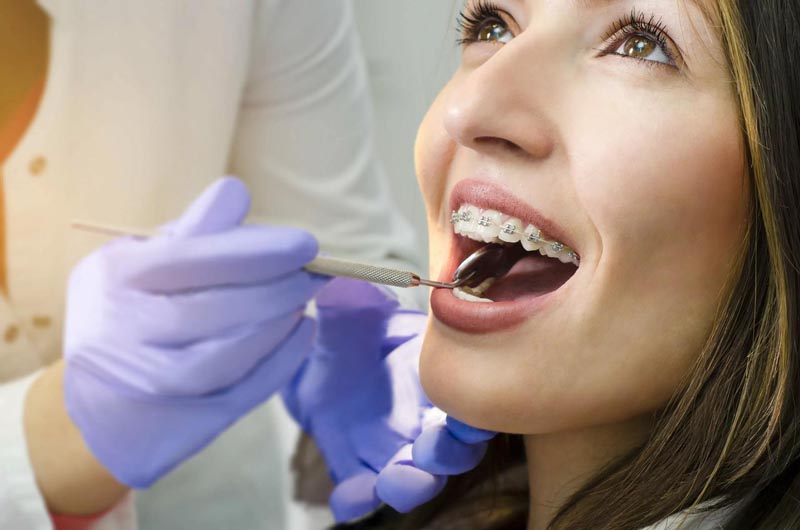Braces Do Wonders for Your Teeth

Your smile is one of the very first things about you that other people notice. It can go a long way in creating a good first impression. However, not everyone has the benefit of having perfect teeth. Often, many people’s teeth grow in crooked, or they sometimes have a misaligned bite, such as an under- or overbite. Having dental issues like crooked teeth or a misaligned bite can have quite an impact on the health of your mouth and your self-esteem, as well. Fortunately for those with teeth issues, there are multiple ways to correct the alignment of your teeth and bite. One of the oldest and most well-known treatments of correcting teeth is braces.
Dental braces are devices that dentists and orthodontists use to correct a malocclusion. While children are the ones who most frequently get braces, more and more adults are using braces to correct their dental issues later in life. Over 4 million people in the United States wear braces. Of that number, roughly 25% of them are adults.
Braces have helped millions of people across the country solve their dental issues. However, many people often question how they work and fear that they will cause them pain and discomfort. Cosmetic & Family Dentistry of Las Colinas is here today to provide you with some information to better understand how braces work.
What Are Braces?
There are different kinds of braces, such as Invisalign braces. However, we are going to be discussing traditional braces today. Their purpose is to correct crooked or misaligned teeth and bites. Many general dentists can do basic alignments, but orthodontists are typically the ones who specialize in correcting issues with teeth. These braces often consist of:
- Brackets: metal squares that are glued to your teeth individually by your orthodontist using a special bonding agent
- Orthodontic Bands: made from stainless steel, clear, or tooth-colored materials that are bonded to your teeth with a dental bonding agent, wrapping around each tooth to provide an anchor for brackets
- Spacers: a small separator that is used to create a tiny space between teeth before bands are placed
- Archwires: wires that are attached to the brackets and connect them, directing the movement of the teeth
- Ligatures: small rubber bands that hold the archwires to the brackets
- Buccal Tubes: a metal piece found on the back molar that anchors the other parts of your braces together at the back of your mouth
- Springs: often placed on archwires to push, pull, open, or close space between teeth
To determine if you need braces, your dentist will review your medical history, take impressions of your teeth, photograph your face and teeth, and x-ray your mouth and head to get a clearer view of the shape of your teeth and jaw. All of this allows them to construct the right fit for your mouth.
How They Work
As we’ve mentioned several times already, an orthodontist will use braces to correct crooked teeth or a misaligned bite. Braces fix your teeth by applying constant pressure over an extended period, slowly moving the teeth in a specific direction until the desired outcome is reached. As pressure is applied, the shape of your jaw and teeth is changed, as your teeth move.
Your dentist will take a mold of your teeth before applying any pieces to them. This mold allows them to appropriately plan what your teeth need to correct them, as well as for deciding where exactly to place brackets. Once the brackets have been placed, your orthodontist will then apply the wire.
The archwires are what guide the movement of your teeth. It’s important to remember that not all wires will be perfectly even. Some will have more bend than others since some teeth may require more or less pressure. Springs can be attached to these wires to help pull, push, open, or close gaps between your teeth. Elastic bands are often added to brackets to apply additional pressure to help move your teeth in the correct direction.
Your teeth are not directly connected to your jaw. Underneath your gums is a part called the periodontal membrane, also known as the periodontal ligament, which surrounds the root of the tooth. This membrane, along with the bone attached to it, responds to the pressure applied to your teeth and decide just how your teeth move. Light, constant pressure works best on the membrane, as it allows your teeth to develop or break down bone cells appropriately.
How Braces Help
The most obvious reason people get braces is to correct their teeth. After all, that’s what they were designed to do. However, there are a host of benefits that braces help correct, including:
- Overcrowding: Teeth that are too close together are much harder to brush and floss, which puts them at a higher risk of gum disease and tooth decay
- Correct Bites: If you have a misaligned bite, you may struggle to bite or chew food correctly or thoroughly, which can lead to your teeth wearing out faster. Your jaw muscles will also tire out much quicker and can even cause jaw pain
- Fix “Buckteeth”: A “bucktooth” appearance occurs when the large front teeth protrude out from under the lip. This makes individuals more likely to suffer a tooth injury.
- Improve Your Appearance: While we understand that looks aren’t everything, we have to acknowledge just how we view our teeth. Over half of Americans are insecure about their smiles. Due to this, they hide their teeth when they talk, which can impact how they speak. When your teeth are fixed, you feel confident in your smile, which helps boost self-esteem and prevent any speech problems.
Braces are complicated applications that only highly trained professionals can apply. This treatment is designed to correct any crooked or misaligned teeth or bites. Braces apply continuous pressure to move your teeth into the desired positions. If you are interested in braces and how they can help you, give Cosmetic & Family Dentistry of Las Colinas a call today.
- Awareness16
- Bad Breath1
- Bone Grafting1
- Braces4
- Causes, Symptoms, And Treatments6
- Cavities5
- Chewing Gum1
- Cosmetic Dentistry of Las Colinas15
- COVID-192
- Deep Cleaning7
- Dental Anxiety1
- Dental Bridge2
- Dental Care27
- Dental Cleaning6
- Dental Crown1
- Dental Filling1
- Dental Health24
- Dental Implants6
- Dental Sedation1
- Dental Visit1
- Dental X Ray3
- Floss1
- Gum Dieseases4
- Injury1
- Insurance1
- Invisalign8
- Oral Cancer1
- Oral Hygiene24
- Root Canal9
- Sleep Apnea2
- Tartar1
- Teeth19
- Thanksgiving1
- TMJ1
- Tongue1
- Veneers2
- White Teeth12
Get Your Best Smile With Us
